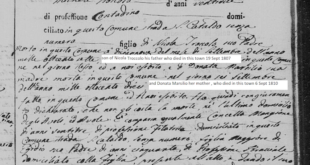In some of my recent columns, I have discussed some lesser-used resources, mostly because A) I have discussed the “most-often-used” resources a lot more, and B) I am finding out how useful these lesser-used resources can be. A recent example was the atti diversi, the records of stillbirths and orphans, with occasional deaths of adults in other towns that you might never have found otherwise. Today’s column concerns something very simple but very necessary sometimes. It is called the “indici decennali.” These are indexes for each town that cover a ten-year period. As we have gone over before, in every …
Read More »Recent agreement spells bad news for genealogists
Depending on which genealogical web site you prefer, there is good, or bad news. In several columns I have mentioned that some Italian genealogical records are available on FamilySearch, some on Portale Antenati, and some on both. Recently, there has been a significant change, one I am profoundly unhappy with. An agreement was signed recently that has done the following: If the records appear on the Antenati site, they will be in the FamilySearch catalog, but you cannot view them EVEN IN A FAMILYSEARCH CENTER OR AFFILIATE, unless you are logged into FamilySearch with a church login. If the records …
Read More »A little know record type with key bits of intel
I usually talk about the primary genealogy records you should all look for: births, marriages and deaths. They are the foundation of genealogy research. For many of our ancestors, they are the only biographical information we have. And for many researchers, those three record types are more than enough to keep them busy. Lately, I have been working with a record type that you may never need, but you ought to know about. These records might solve problems you have had for a while. They are called “Atti Diversi.” It sounds like “random stuff.” “Stuff that doesn’t fit the other …
Read More »Tales of extreme genealogy
When you’re researching your family tree, and you find a record you are looking for, sometimes it seems so bizarre that you question what you saw. “That can’t be right,” you think, “can it?” I’ve been at this for more than three decades, so I have had many such moments. Sometimes, I go back to a family I haven’t looked at for a long time, and I see something that doesn’t look quite right. This can be for many reasons. Sometimes, it can be a data entry error in your computer. “Hmm…I have someone who was born in 1943 and …
Read More »Birth record sidebars can contain intel gems
Over the years, I have taught a lot of people how to read Italian birth records. However, having plowed through a lot of birth records recently, I need to promote the use of the “annotation” that may appear on the birth record. A lot of information can appear in an annotation that might not be available on a regular record. It might refer to an event that took place in a town that has no records available to us, or a year that is too recent for FamilySearch to release to us. So what is an annotation? Usually in a …
Read More »What the genealogy landscape looks like after POINT
Around 1987, there was a man who had a vision for Italian genealogy. His name was Dr. Thomas Militello, from California and eventually Nevada. Dr. Tom had trouble trying to find genealogists who were researching the same towns as he was, and what surnames they were researching. Keep in mind that this was the late 1980s so ancestry.com and FamilySearch did not exist as we know them today and social media was years in the future. Dr. Tom founded a group called POINT, which stands for Pursuing Our Italian Names Together. The objective of POINT was to get people to …
Read More »What do you do when you hit a ‘brick wall’?
Most genealogists are familiar with the term “brick wall.” We use it to describe a situation where we think we have tried every possibility to find some piece of information but have come up empty. Sometimes, the information exists but it’s not on the internet. You might have to go to some courthouse in South Carolina, or write to them, to get a copy or an extract of somebody’s birth record. Sometimes, the information is on the internet but you have to either pay a subscription fee, or go to a public library or FamilySearch center to use their web …
Read More »Locating hidden treasures in Italian records
After more than three decades of Italian research, I thought I knew it all. Actually, I know I don’t — know it all — but I also don’t spend a lot of time looking again at the same records I have already reviewed and set to rest. Recently I saw a YouTube interview by Bob Sorrentino on his “Italian Roots and Genealogy” channel. I was interviewed for this channel about a year ago on the topic of “Researching Triggiano to Chicago.” A number of notable Chicagoans like Dominic Candeloro and Carla Simonini have also been on this channel. But a …
Read More »A good place to dig when looking for a gravesite
Let’s pretend we’re at a trivia contest and the next question is, “What’s the word for someone who has an interest in cemeteries?” You could answer “cemetery enthusiast” or “grave hunter” but those would be wrong because the question asks for a single word. It turns out that the word is “taphophile” pronounced “TAF-oh-file.” The moniker has a Greek root, “taphos,” which is a catch-all word for anything to do with funerals, burials, etc. It can be part of the ritual of the death of a loved one to attend a wake, drive in procession to a church and then …
Read More »Online options when searching for vital records
Recently, I was asked to do a presentation on Cook County Vital records. For anyone who has relatives in Chicago and the suburbs, this is an essential part of research. Vital Records are a specific subset of the many types of records available to genealogists. No matter what part of the country or the world you research, vital records are: Birth certificates Marriage Licenses Death certificates Because they form the backbone of our research, we need them the most. Before there were web sites, we used to have to order copies of these documents from the Cook County Clerk’s office. …
Read More » Fra Noi Embrace Your Inner Italian
Fra Noi Embrace Your Inner Italian











